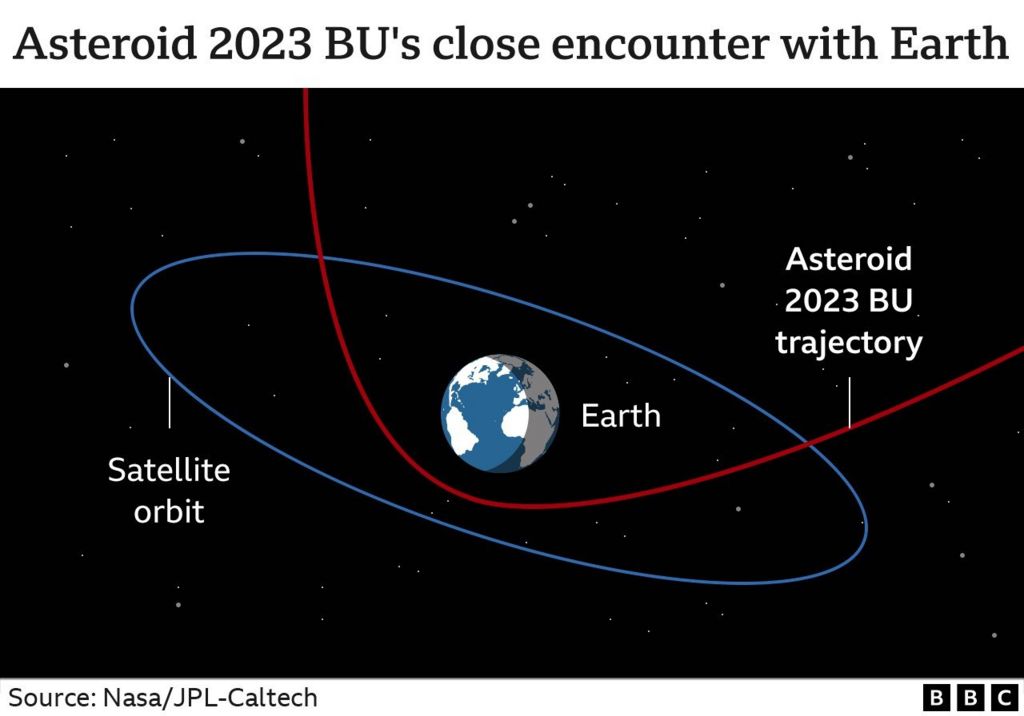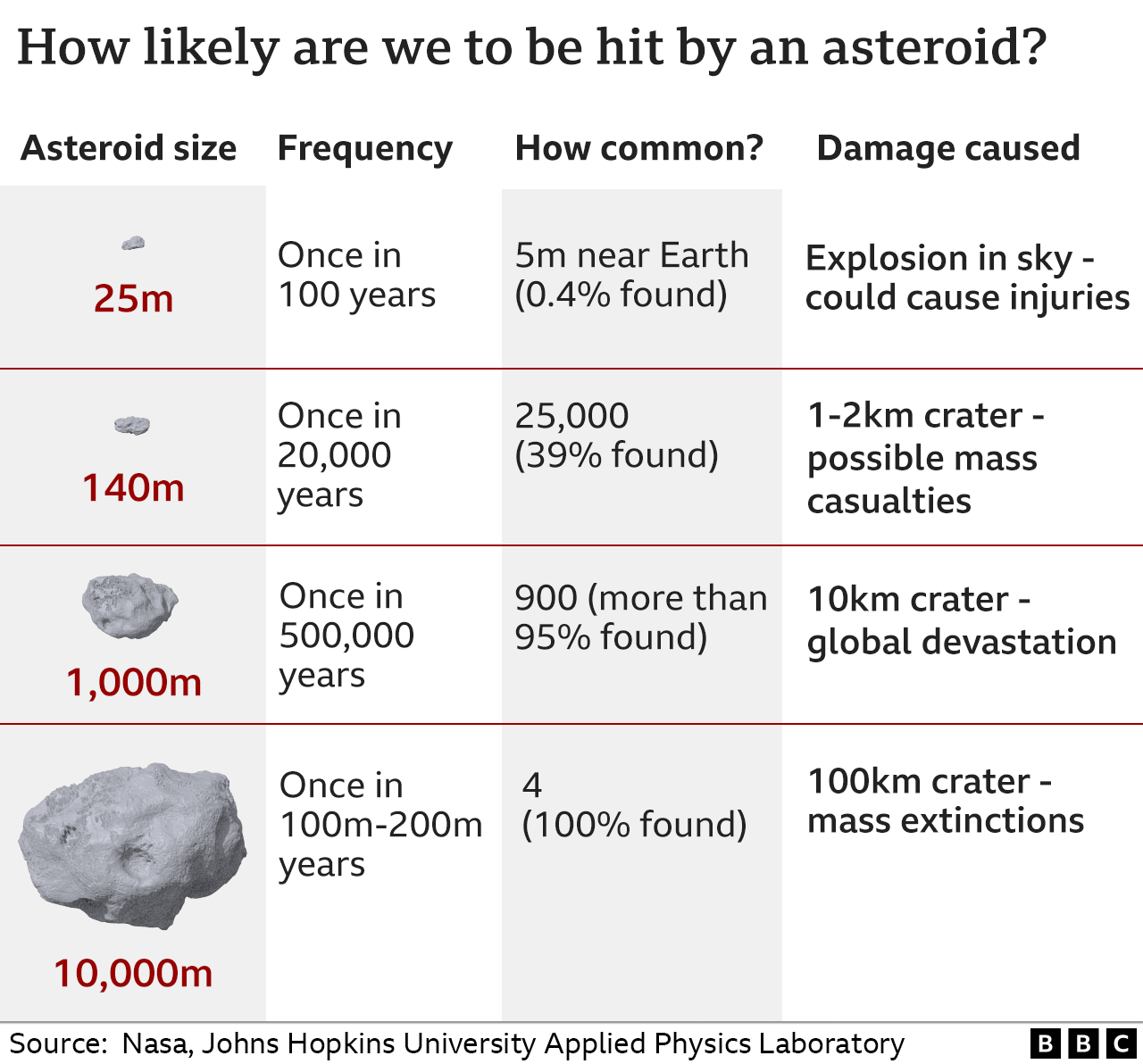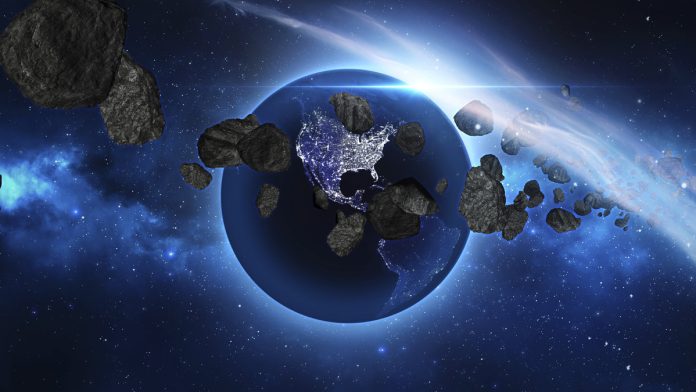Asteroid (Space rock) passes closer than some satellites
Now it’s over, we can say it: a biggish asteroid passed by Earth a short while ago.
About the size of a minibus, the space rock, known as 2023 BU, whipped over the southern tip of South America just before 00:30am GMT.
With a closest approach of 3,600km (2,200 miles), it counts as a close shave.And it illustrates how there are still asteroids of significant size lurking near Earth that remain to be detected.

This one was only picked up last weekend by amateur astronomer Gennadiy Borisov, who operates from Nauchnyi in Crimea, the peninsula that Russia seized from Ukraine in 2014.Follow-up observations have refined what we know about 2023 BU’s size and, crucially, its orbit.
That’s how astronomers could be so confident it would miss the planet, even though it came inside the arc occupied by the world’s telecommunications satellites, which sit 36,000km (22,000 miles) above us.The chances of hitting a satellite are very, very small.
The time of lowest altitude was accurately calculated to be 19:27 EST on Thursday, or 00:27 GMT on Friday.

Even if 2023 BU had been on a direct collision course, it would have struggled to do much damage.
With an estimated size of 3.5m to 8.5m across (11.5ft to 28ft), the rock would likely have disintegrated high in the atmosphere. It would have produced a spectacular fireball, however.
For comparison, the famous Chelyabinsk meteor that entered Earth’s atmosphere over southern Russia in 2013 was an object near 20m (66ft) across. It produced a shockwave that shattered windows on the ground.
Scientists at the US space agency Nasa say 2023 BU’s orbit around the Sun has been modified by its encounter with Earth.
Our planet’s gravity pulled on it and adjusted its path through space.
“Before encountering Earth, the asteroid’s orbit around the Sun was roughly circular, approximating Earth’s orbit, taking 359 days to complete its orbit about the Sun,” the agency said in a statement.
“After its encounter, the asteroid’s orbit will be more elongated, moving it out to about halfway between Earth’s and Mars’ orbits at its furthest point from the Sun. The asteroid will then complete one orbit every 425 days.”
There is a great effort under way to find the much larger asteroids that really could do damage if they were to strike the Earth.

The true monsters out there, like the 12km-wide rock that wiped out the dinosaurs, have likely all been detected and are not a cause for worry. But come down in size to something that is, say, 150m across and our inventory has gaps.
Statistics indicate perhaps only about 40% of these asteroids have been seen and assessed to determine the level of threat they might pose.
Such objects would inflict devastation on the city scale if they were to impact the ground.Prof Don Pollacco from the University of Warwick, UK, told BBC News: “There are still asteroids that cross the Earth’s orbit waiting to be discovered.
“2023 BU is a recently discovered object supposedly the size of a small bus which must have passed by the Earth thousands of times before. This time it passes by only 2,200 miles from the Earth – just 1% of the distance to the moon – a celestial near miss.
“Depending on what 2023 BU is composed of it is unlikely to ever reach the Earth’s surface but instead burn up in the atmosphere as a brilliant fireball – brighter than a full moon.
“However, there are likely many asteroids out there that remain undiscovered that could penetrate the atmosphere and hit the surface to cause significant damage – indeed many scientists think we could be due such an event.”




